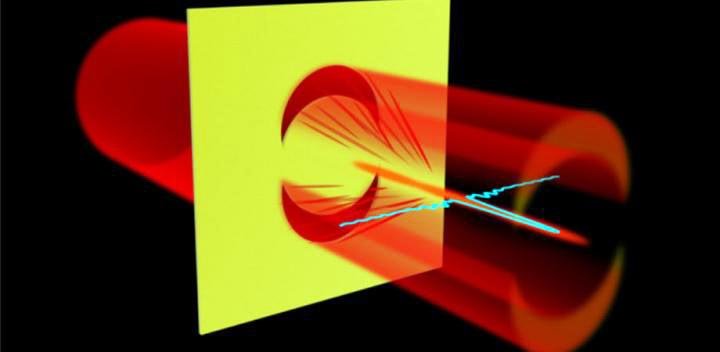Optical superoscillation without side waves

A pair of moonlike sharp-edge apertures enables generation of diffractive focusing light spot sized within the optical diffraction limit, while eliminating side waves along the symmetric cut.
Credit: Yanwen Hu
A sharp-edged aperture is a promising solution for eliminating side lobes from superoscillatory waves.
Optical superoscillation refers to a wave packet that can oscillate locally in a frequency exceeding its highest Fourier component. This intriguing phenomenon enables production of extremely localized waves that can break the optical diffraction barrier. Indeed, superoscillation has proven to be an effective technique for overcoming the diffraction barrier in optical superresolution imaging. The trouble is that strong side lobes accompany the main lobes of superoscillatory waves, which limits the field of view and hinders application.
There also are tradeoffs between the main lobes and the side lobes of superoscillatory wave packets: reducing the superoscillatory feature size of the main lobe comes at the cost of enlarging the side lobes. This happens mainly because superoscillation is a local phenomenon, yet the overall width of the wave packet is wider than the optical diffraction limit.
Precise engineering of the interference of diffracted light fields emitted from complex nanostructures can produce structural masks that enable significant optical superoscillation. But structural masks require optimization and complex fabrication, and the resulting light field is still limited by high-intensity side lobes. Producing superoscillatory waves with appreciable feature size while maintaining a larger field of view has remained challenging until now.
As reported in Advanced Photonics, researchers from Jinan University, Guangzhou, China, recently developed a way to eliminate, to some extent, the tradeoffs involved in superoscillatory wave packets. They demonstrate, both experimentally and theoretically, generation of superoscillatory light spots without side lobes.
A central microdisc with cylindrical diffraction gives rise to a superoscillatory light spot of a size within the optical diffraction limit. A pair of sharp-edged apertures ensures constructive interference with the high-spatial-frequency waves. That interference effectively eliminates side lobes along a symmetric cut that can be adjusted in the transverse plane by rotating the moonlike apertures.
According to Yanwen Hu, a doctoral student working under the supervision of Zhenqiang Chen in the Department of Optoelectronic Engineering at Jinan University, “Due to its easy design, based on clear physics, the sharp-edged aperture is a promising candidate for realization of superoscillatory waves.”
Hu explains further that the cylindrical diffraction of the central microdisc produces superoscillatory waves with Bessel-like forms. These forms enable the delicate structures of the superoscillatory waves propagating in free space to travel much farther than the evanescent light waves. According to Hu, this intriguing propagation effect of superoscillation holds promise for potential application in nanoparticle manipulation, as well as superresolution imaging.
###
Read the open access article by Yanwen Hu et al., “Optical superoscillatory waves without side lobes along a symmetric cut,” Adv. Photonics 3(4), 045002 (2021), doi 10.1117/1.AP.3.4.045002.
All latest news from the category: Physics and Astronomy
This area deals with the fundamental laws and building blocks of nature and how they interact, the properties and the behavior of matter, and research into space and time and their structures.
innovations-report provides in-depth reports and articles on subjects such as astrophysics, laser technologies, nuclear, quantum, particle and solid-state physics, nanotechnologies, planetary research and findings (Mars, Venus) and developments related to the Hubble Telescope.
Newest articles

Sea slugs inspire highly stretchable biomedical sensor
USC Viterbi School of Engineering researcher Hangbo Zhao presents findings on highly stretchable and customizable microneedles for application in fields including neuroscience, tissue engineering, and wearable bioelectronics. The revolution in…

Twisting and binding matter waves with photons in a cavity
Precisely measuring the energy states of individual atoms has been a historical challenge for physicists due to atomic recoil. When an atom interacts with a photon, the atom “recoils” in…

Nanotubes, nanoparticles, and antibodies detect tiny amounts of fentanyl
New sensor is six orders of magnitude more sensitive than the next best thing. A research team at Pitt led by Alexander Star, a chemistry professor in the Kenneth P. Dietrich…





















